The deadly chytrid fungus renders unique frogs extinct and threatens another species in Australia.
High up in the relatively pristine rain forest streams of the Blackall and Conondale Ranges in South East Queensland, Australia, there once lived a semi-aquatic frog species with a reproductive strategy like no other. Its name was the southern gastric brooding frog (Rheobatrachus silus), and it was only discovered in 1972.
During the spring season, the male frog’s call would lure potential mates to shallow sections along the streams. After a successful courtship, the female frog would lay eggs and then swallow these newly fertilized eggs. Rather than becoming a nutritious treat, the frog eggs would produce a hormone that prevented the release of digestive acids. Over the following weeks, the eggs would hatch, proceed through their tadpole stage and move toward metamorphosis within the safety of the mother frog’s stomach. After six to eight long weeks, small versions of the mother would emerge from her mouth, ready for life on the streams. This frog species became extinct in 1981.
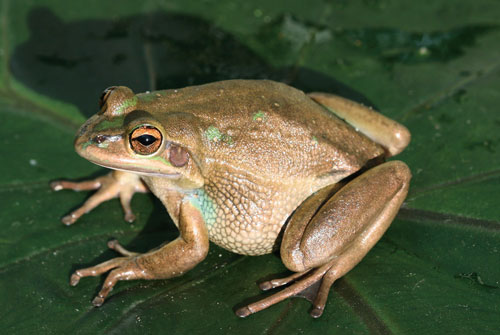
Photo Credit: Michael McFadden
Endangered green and golden bell frog (Litoria aurea).
Loss of the Northern Gastric Brooding Frog
A little more than 460 miles to the north, in the protected forests of Eungella National Park, Australia, a second gastric-brooding frog species was discovered in 1984, giving scientists a new opportunity to study this bizarre reproductive behaviour. With such pristine habitat, one would have thought that the status of this frog species would be secure. Unfortunately, the northern gastric brooding frog (R. vitellinus) then became extinct the following year in 1985. With the disappearance of these two frog species, Australia not only lost a unique taxa with an unusual method of reproduction, but also any medicinal value for treating gastrointestinal ailments (including stomach ulcers) that these frog species could have provided.

Photo Credit: Michael McFadden
Chytrid fungus has caused the waterfall mist frog (Litoria nannotis) to decline to critically low numbers.
The disappearance of these frog species marked a bleak time in the history of Australia’s amphibian fauna. From 1975 to 1995, six species of endemic frogs were sighted for the last time. For one of these species, the sharp-snouted day frog (Taudactylus acutirostris), a last-minute attempt was made to prevent its extinction by securing the last remaining wild tadpoles for captivity. A number of tadpoles were gathered and sent to two zoos and two universities. Unfortunately, this proved to be too little too late. The last of this frog species died in captivity in 1995 from the same disease that undoubtedly helped to cause their extinction in the wild: chytridiomycosis, caused by the deadly chytrid fungus (Batrachochytrium dendrobatidis).
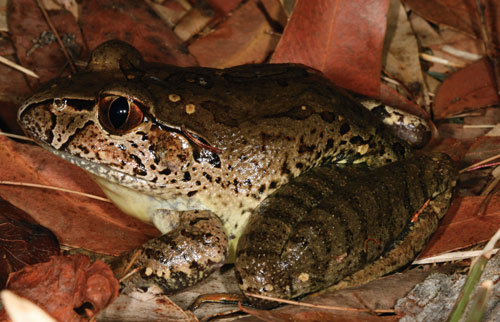
Photo Credit: Michael McFadden
Endangered giant barred frog (Mixophyes iteratus).
Chytrid fungus is An Insidious Killer
Chytrid fungus was not officially discovered until 1998 and formally described until 1999. By this time, it was already causing devastating effects to the amphibians of Australia and Central America. The first historical evidence of the pathogen in Australia can be traced back to a museum specimen of the dainty treefrog (Litoria gracilenta) collected in 1978. It is believed that it invaded South East Queensland, Australia, soon before then and travelled north and south at a rate of approximately 60 miles per year. This same pattern of movement correlated with a wave of frog declines and disappearances.
Although habitat loss, introduced predators and a number of other threats have affected the frogs of Australia, no threat has struck as rapidly and with as devastating an effect as chytrid fungus. Stream-dwelling frogs that have abounded in numbers one year have disappeared the next as the fungus slowly spread along Australia’s east coast. Currently, close to a quarter of the approximately 230 frog species in Australia are now listed as threatened with extinction.
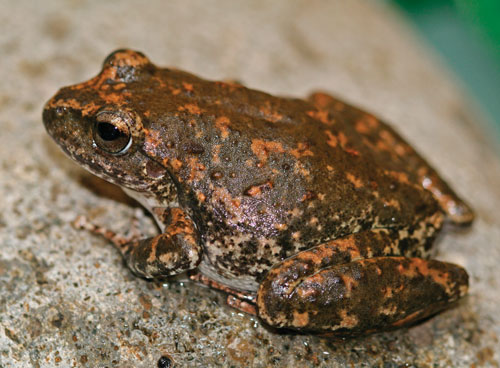
Photo Credit: Michael McFadden
A captive breeding program has been established at Taronga Zoo for the critically endangered booroolong frog (Litoria booroolongensis).
Australian Zoos Respond to Chytrid Fungus
The unprecedented rate of amphibian declines in Australia has resulted in the need for an urgent response by the zoo community. Zoos are placed in a unique position of responsibility, as they possess the required husbandry skills to manage a frog conservation program, and they have the ability to expose the plight of these declining species to a broad audience. Historically, amphibians have not comprised a large part of zoological collections. The many roles that zoos can play in this crisis have only recently been realized.
As late as 2001 there were only a total of three threatened frog species in Australian zoos. Three years later in 2004, this number had only increased to include a fourth species. One of these species was the green and golden bell frog (Litoria aurea). This medium-sized, pond-dwelling frog was once extremely common throughout South East Australia, especially in the Sydney area. However, with increasing land clearing, the introduction of the eastern mosquitofish and the arrival of chytrid fungus, this frog species quickly slid into its current endangered status. Between 1996 and 2004, a breeding program at the Taronga Zoo in Sydney resulted in the release of 20,000 tadpoles and frogs of this species at five sites in the greater Sydney area. Another captive amphibian breeding program took place at the same time at Melbourne Zoo. There, Romer’s treefrog (Chirixalus romeri), an endemic to Hong Kong, were successfully bred and returned to their country of origin as part of a collaborative release program with Hong Kong University.
Fortunately, in recent years the number of frog conservation programs in Australian zoos has rapidly expanded. By 2007 the number of threatened amphibian species being held for conservation programs had jumped to 11, including some of the most threatened species in Australia. As of 2010, this number has increased further to 13, with six institutions setting up dedicated amphibian quarantine facilities. Many of these species are being held for multiple purposes, including insurance populations, research, education and reintroduction programs.
Endangered Frog Fights On
In the cooler climates of Australia’s snowy mountains, the country’s most vividly colored amphibian is fighting for its existence. The southern corroboree frog (Pseudophryne corroboree) is a small terrestrial frog, reaching a maximum length of only an inch. It is most easily distinguished from other frog species by its striking coloration. Bright yellow and jet-black longitudinal markings alternate on the back of the frog. Like many other species of frogs with vibrantly colored markings, the markings of the corroboree frog serve as a warning to potential predators. It produces two classes of alkaloids within its glandular skin that are toxic to all known predators. In fact, one of these alkaloids, the pumiliotoxins, are shared with the dart frogs of South and Central America.
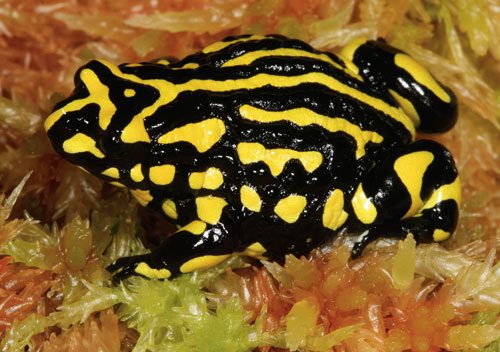
Photo Credit: Michael McFadden
Critically endangered southern corroboree frog (Pseudophryne corroboree).
The southern corroboree frog has a very restricted distribution. It is found only within the boundaries of Kosciuszko National Park, in the southeastern part of the state of New South Wales, Australia. This area is the coolest region in Australia, with significant snowfall during the winter months of June through August. Within the national park, this frog species is mostly restricted to the sphagnum bog systems at the fairly high elevation of between 4,200 to 5,800 feet.
During the summer months, from January to March, the male frogs prepare a nesting chamber along pool edges. Here they will call to attract female frogs. In one breeding season as many as 10 female frogs could enter a single nesting area, each laying between 16 and 38 eggs within the mossy nest. For such a small frog species, the eggs are very large, with the swollen egg capsules reaching a diameter of 9 millimeters. The frog eggs will remain in the nest until significant rain or snow melts during autumn or winter allow the tadpoles to hatch and enter the pools.
For more than 20 years, southern corroboree frog populations have declined throughout their range. Most of the former populations have totally disappeared, and those that still exist contain very few specimens. Each year additional bogs where the frogs once existed fall silent during the breeding season. Many experts predict that at the current rate of decline, this frog species may be extinct in the wild within the next decade. Some estimates indicate that there may be fewer than 150 specimens left in the wild. For one of Australia’s most cherished frogs, this is a very grim predicament.
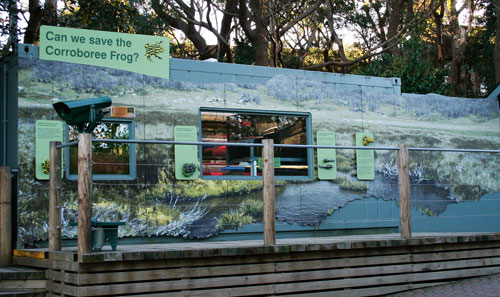
Photo Credit: Michael McFadden
Corroboree frog facility at Taronga Zoo.
The cause behind the southern corroboree frog’s demise is believed to be infection with the lethal chytrid fungus. These frogs are particularly susceptible to the fungus, often dying soon after becoming infected. Other common threatening factors, such as habitat clearance and feral predators, pose little risk to this frog species due to their protected national park habitat and their toxic skin. Unfortunately, the impact of the disease on this species is unlikely to reduce quickly. Living alongside the corroboree frog is the eastern common froglet (Crinia signifera), a species which appears to be resistant to chytrid fungus. Although resistant, the eastern common froglet will still carry large numbers of zoospores on its skin, allowing the fungus to persist in the sphagnum bog environment.
Strategy to Save the Southern Corroboree Frog
In an effort to save the southern corroboree frog from imminent extinction, a multi-institutional recovery team was set up, including representatives from the state wildlife authority, the Department of Environment, Climate Change and Water and zoos and universities, including Taronga Zoo, Zoos Victoria, the Amphibian Research Centre, Tidbinbilla Nature Reserve, the University of Canberra and the Murray Catchment Management Authority. Through this collaboration, much research has been done on the species’ biology and its threatening factors. With the continuing declines, it has now been recognised that the last hope for the southern corroboree frog is the success of captive-breeding programs for the species. Currently, a large program exists at three Australian zoos (Taronga Zoo, Melbourne Zoo and Healesville Sanctuary) and a private amphibian facility, the Amphibian Research Centre. Between these facilities, a total of almost 4,000 individual southern corroboree frogs are currently held.
One zoo participating in the fight to save this frog species with a large public display is Taronga Zoo. Two dedicated amphibian conservation facilities located at the zoo are designed to breed and rear large numbers of these frogs, which will then be used for further breeding, research or reintroduction attempts. The facilities were constructed from former refrigerated shipping containers. These shipping containers have proven to make ideal facilities to house frogs, due to their excellent insulation, waterproofing and the ease of which quarantine procedures can be implemented. The use of these containers for amphibian conservation was pioneered at the Amphibian Research Centre, where the bulk of the captive southern corroboree frog population is maintained.
There are close to 350 frogs at the zoo’s facility, which could be double the number remaining in the wild. Through large windows, zoo visitors can see this frog species at all stages of development, including eggs, tadpoles and metamorphosed frogs of all ages. Whilst viewing a frog species close to the brink of extinction and a 20-foot conservation lab in its entirety, visitors can also trace the plight of the corroboree frog in the wild through the colorful interpretative graphics affixed to the container. Although there is little that zoo visitors can physically do to help conserve this particular frog species, the Taronga Zoo has an excellent opportunity to educate the public about this frog’s decline and raise awareness about the decline of many other species.
Though still in the relatively early stages, the captive component of the conservation program for this frog species is progressing well. Most institutions have had good success rearing the frogs through the egg and tadpole stages. Breeding the frogs has proved challenging in previous years, but the most recent season has seen great success with large numbers of clutches produced. In future years, it is planned that large numbers of captive-laid frog eggs will be produced for reintroduction into chytrid-excluding artificial pools in the frogs’ natural habitat to allow the frog species to remain persistent in the wild for many years to come.
With the extinction of more than 150 amphibian species worldwide in recent decades, captive-breeding programs provide us with the opportunity to preserve many species. In recent years, there has been a large increase in research dedicated to studying the threats facing amphibians in the wild. This is especially true for research on the interactions between chytrid fungus and amphibians. It is hoped that in future years, with a greater understanding of how these threats impact various amphibian species, we will be able to return these threatened species to the wild so that our future generations will enjoy their diversity of calls for many years to come.
MICHAEL McFADDEN is the unit supervisor of the herpetofauna division at Taronga Zoo in Sydney, Australia. He currently works on a number of threatened amphibian captive-breeding and reintroduction programs, including those for the critically endangered corroboree frogs and yellow-spotted bell frogs. To learn more about the corroboree frog and how you can help, please visit www.corroboreefrog.com.au.

